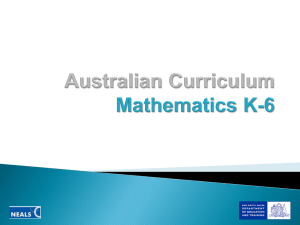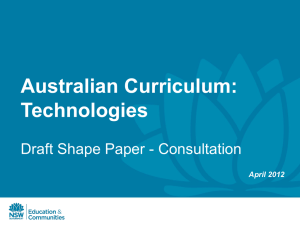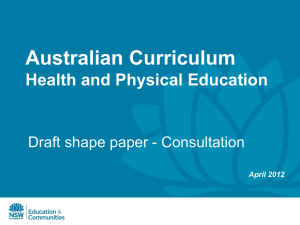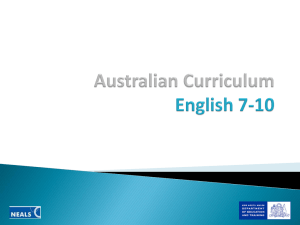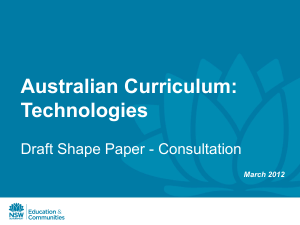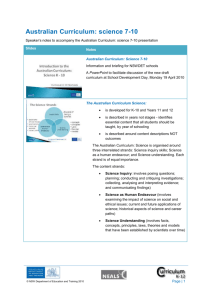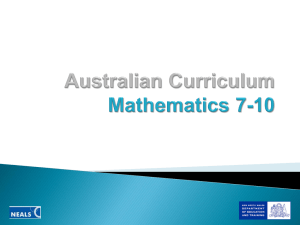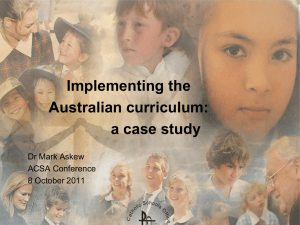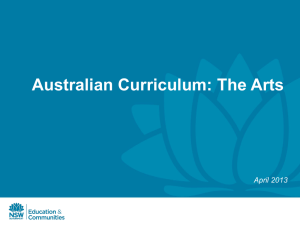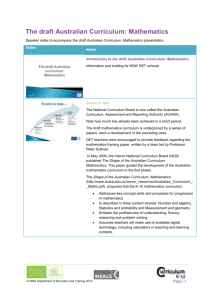Australian Curriculum: English 7-10
advertisement
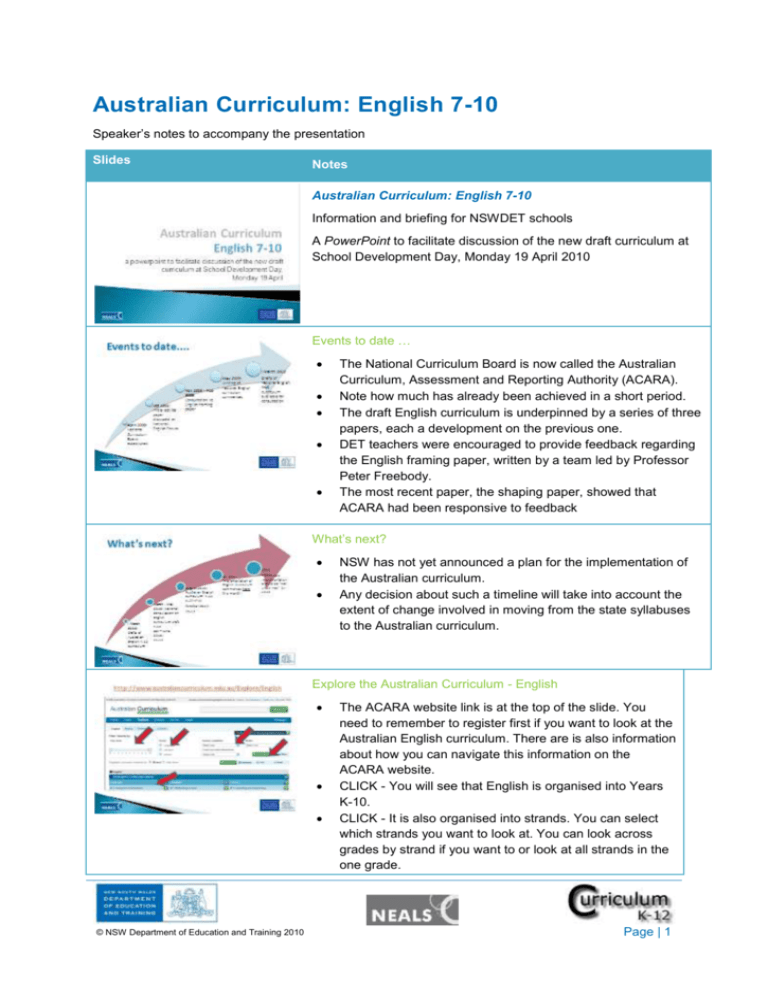
Australian Curriculum: English 7-10 Speaker’s notes to accompany the presentation Slides Notes Australian Curriculum: English 7-10 Information and briefing for NSWDET schools A PowerPoint to facilitate discussion of the new draft curriculum at School Development Day, Monday 19 April 2010 Events to date … The National Curriculum Board is now called the Australian Curriculum, Assessment and Reporting Authority (ACARA). Note how much has already been achieved in a short period. The draft English curriculum is underpinned by a series of three papers, each a development on the previous one. DET teachers were encouraged to provide feedback regarding the English framing paper, written by a team led by Professor Peter Freebody. The most recent paper, the shaping paper, showed that ACARA had been responsive to feedback What’s next? NSW has not yet announced a plan for the implementation of the Australian curriculum. Any decision about such a timeline will take into account the extent of change involved in moving from the state syllabuses to the Australian curriculum. Explore the Australian Curriculum - English © NSW Department of Education and Training 2010 The ACARA website link is at the top of the slide. You need to remember to register first if you want to look at the Australian English curriculum. There are is also information about how you can navigate this information on the ACARA website. CLICK - You will see that English is organised into Years K-10. CLICK - It is also organised into strands. You can select which strands you want to look at. You can look across grades by strand if you want to or look at all strands in the one grade. Page | 1 CLICK - The general capabilities, cross-curriculum dimensions and modes can also be selected. CLICK - You can then click on apply filters to sort your view. CLICK - This example shows a search for Kindergarten showing all the strands with their content descriptions. The introduction (found in Learn) to this curriculum is very important to download and read. The strands The curriculum is organised into three strands: language, literature and literacy. These will be discussed in the next slide. CLICK - The modes are familiar to teachers in NSW. Note that the composing of multimodal texts, with a visual component, is called creating in the draft Australian curriculum – in NSW we call this mode representing. The mode of viewing has been subsumed under reading and creating has been included in writing – an organisation which is similar to that used in the NSW English K-6 Syllabus. The modes are woven through each of the strands. The strands The three strands are presented discretely, but the curriculum emphasises that these strands should be “interwoven” in the classroom. Note that this is a summary of the information in the introductory section of the English curriculum. Discuss the definition of literature – aligns with the range of texts that are the subject of interpretation, appreciation, evaluation and creation in NSW. The strands © NSW Department of Education and Training 2010 Thinking about what these strands represent and how they work together is important to this curriculum. The draft English curriculum strongly emphasises the need to integrate the three strands in classroom teaching. How much time is devoted to each strand may vary according to the requirements for the year level as well as the previous learning and needs of students. Page | 2 Language, literacy and literature This diagram represents an attempt by the English Unit at Curriculum Directorate to show the relationships between the three strands. Language is mostly learning about language and how it works. Literacy is generally learning to listen, view, read, speak and write and create texts. These two strands would nearly always work hand in hand. Literature is the most significant way in which students use their knowledge and skills of language and literacy in the study of English – they learn through literature. Content description and elaborations The curriculum is organised according to years, not stages. Within each strand for each year there are several points of content description. The content elaborations provide examples of the content descriptions – they are not as comprehensive as the NSW syllabus content that sits beneath the outcomes. ACARA plans to add resources to support the content descriptions, but they are not evident in the draft curriculum. The achievement standards describe the levels of student achievement typical of a given year. Student work samples are provided to illustrate the achievement standards. Some work samples are now available for Years 6 and 7, but ACARA obviously plans to add more work samples in the future. Content descriptions with elaborations © NSW Department of Education and Training 2010 This is an example of the Year 6 content descriptions with elaborations. The layout is the same for Years 7 to 10. Page | 3 Achievement standards This slide shows an example of achievement standards for Kindergarten. CLICK - The achievement standards are organised according to the modes. This is similar in design to the K-12 stage statements in the English 7-10 Syllabus. What should be familiar? A good starting point in exploring the Australian English curriculum is to consider and acknowledge what is familiar to teachers. What may be less familiar? These possible differences have been suggested in earlier consultations. Evaluating the Australian English curriculum The next four slides relate to suggestions for approaches you may take when looking at the Australian English curriculum. (Read the slide) Two ways to view © NSW Department of Education and Training 2010 There are several approaches you can take to reading the draft curriculum for the purpose of evaluating it. The website filter easily allows you to read the draft syllabus in particular ways. Page | 4 Looking forward – looking back This is a draft curriculum that is open for consultation and feedback. Our focus with this consultation is to work towards making this curriculum the best it can be for our students now and in the future. Therefore it is important that we look forward and consider what we want as well as looking back and mapping it against our current syllabus. (Read slide) Key questions These key questions might be used to evaluate any new curriculum. Identifying the issues Some possible issues have already been identified in earlier consultations. Teachers may require support to deal with these aspects of the new curriculum. Sharing your views: DET online forum To register for the forum: http://currk12.janison.com/curriculum/register/register.htm If you have any problems with registering please contact Chris Dorbis via email or telephone 98867496. If you have been issued a password, please click on the following link to enter the forum. To enter the forum: http://currk12.janison.com/toolbox/desktop/logon.asp The latest version of the Australian English curriculum and this PowerPoint are available in the forum. Sharing your views: other avenues Secondary English teachers may also choose to share their views about the Australian English curriculum via: English Teachers’ Association http://www.englishteacher.com.au/ NSW Board of Studies http://www.boardofstudies.nsw.edu.au/ or directly to ACARA http://www.acara.edu.au/home_page.html © NSW Department of Education and Training 2010 Sharing your views A 7-10 online forum has been established to enable DET teachers to have their say about the Australian English curriculum. You must register before entering this forum. The forum also allows you to read the views of other English teachers and to engage in a professional dialogue with them. Sharing your views: other avenues These other avenues are available to English teachers to share their views about the draft Australian English curriculum. Page | 5
